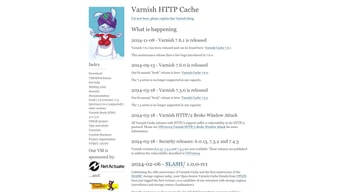

Unclaimed: Are are working at Varnish Cache ?
Varnish Cache Reviews & Product Details
Varnish Cache is an open-source HTTP accelerator designed for content-heavy dynamic web sites as well as APIs. It is used by millions of websites to speed up content delivery and reduce server load. Varnish Cache is known for its flexibility and configurability, allowing custom caching policies through its Varnish Configuration Language (VCL). It supports high-performance caching with minimal hardware requirements, making it a popular choice for businesses of all sizes.

| Capabilities |
|
|---|---|
| Segment |
|
| Deployment | Cloud / SaaS / Web-Based, Desktop Linux, Desktop Mac, Desktop Windows, On-Premise Linux, On-Premise Windows |
| Training | Documentation |
| Languages | English |

Compare Varnish Cache with other popular tools in the same category.

The amount of connections this will handle is massive. The configuration allows you to apply extremely granular control over when to use what backend, how long to cache something, and any number of routing considerations.
The configuration allows complete customization, with that it is also easy to shoot yourself in the foot. But running on Linux, most of us are accustomed to various foot-guns anyway, so I would say it's no different than anything else really.
Shields our backend servers from having to process PHP code constantly, becuase much of the content can be rendered once per day and served from cache. We also have "saint" configuration which will keep the site up even when the backend servers are non-responsive and as long as there is a cached version (even it it would have expired) will still serve content which adds to our uptime.
Varnish is a highly effective caching technology that has assisted us in delivering fast web and streamlining experiences to vast audiences. It seamlessly handles work for content-heavy dynamic websites. From streamlining the handling of surges in demand to keeping expenses manageable the software integrates the adaptability of open-source technology to boost revenue and growth.
I've had a seamless experience while using Varnish Cache. However, have not faced any issues with its feature and consequently, there is nothing about this product that I don't like.
In our organisation, we use Varnish Cache as a performance acceleration tool to enhance the speed and reliability of our website.
It's supported natively by most of our hosting partners, easily integrated with our typical CMS (Drupal), and provides an immediate, impressive performance boost.
It can be difficult to configure at times, and is prone to being more persistent than expected.
Site performance, caching rendered pages in Drupal.


